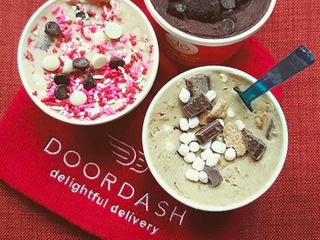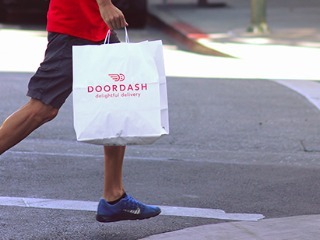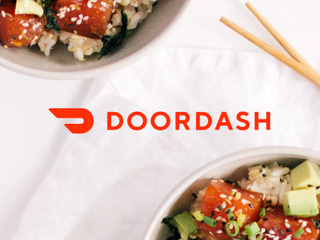When BetterHelp was young: the early years
BetterHelp and Vator have teamed up for Becoming Us, a virtual group therapy program
Read more...
As our readers know, Vator has started a series called When they were young.
It's a look back at the modest days of startups, what traction they had in their first few years, and how they evolved. In the end, we hope to provide a glimpse into what great startups looked like in their first few years.
Stories like these are always well received because it reminds us that anyone, regardless of pedigree and environment, can rise above the noise and have great influence. They show us the value of being resilient, persistent, and committed. If we can follow their footsteps, maybe we too can have similar success.
This segment is on DoorDash.
— DoorDash's First Year —
Founders: Evan Charles Moore, Andy Fang, Stanley Tang and Tony Xu, all students at Stanford.
Founded: October 2012
Initial company description: Originally called Palo Alto Delivery, "DoorDash began with a simple mission: to enable every merchant to deliver," the company says in October 2013. The inspiration comes from a woman named Chloe, the owner of a macaroon store in Palo Alto called Chantal Guillon.
"Our story began back in the fall of 2012 at a small macaroon store in downtown Palo Alto. The four of us were working on building technology for small business owners and getting feedback on an app we’d built. We spent a long time talking with Chloe, the store manager, learning about her day-to-day life. But in the end, our app didn’t solve her most important problems," the team writes.
"Just as we were about to leave, Chloe bursted out, “Well, there is one thing I wanted to show you.” She took out a thick booklet. It was pages and pages of delivery orders. “This drives me crazy. I have no drivers to fulfill them and I’m the one doing all of it.
And that was the lightbulb moment."
Launch, at three months from founding: The company makes its first delivery on January 12, 2013. It starts out by making deliveries on the Stanford campus.

Incorporation, at seven months from founding, four months from launch: On May 21, 2013, DoorDash is incorporated in Delaware.
 Name change, at eight months from founding, five months from launch: In June 2013, the company officially changes its name to DoorDash.
Name change, at eight months from founding, five months from launch: In June 2013, the company officially changes its name to DoorDash.

Press coverage, at nine months from founding, six months from launch: In July 2013, DoorDash is profiled in TechCrunch, in an article entitled, "Y Combinator-Backed DoorDash Delivers Food Quickly In South Bay, Hopes To Expand Beyond Food."
"It’s a crowded space, but while competitors like Seamless and GrubHub offer users an app to order food from any restaurant that has its own drivers and delivery-system setup, DoorDash hires and manages its own drivers, so it can bring you food from restaurants that don’t have their own delivery drivers. That may not seem like a big difference, but for the suburbs and college campuses, it’s a welcome change from having just pizza and Chinese food places offering delivery," it says in the article.
— DoorDash's Second Year —
Second funding, at one year from founding, nine months from launch: In October 2013, DoorDash raises $2.4 million in a seed round from investors that include Khosla Ventures, Charles River Ventures, SV Angel, Paul Buchheit, Pejman Mar Ventures, Andy Rachleff and Russell Siegelman.
"Ultimately, our vision is to build the local, on-demand Fedex. We are a logistics company more so than a food company. We help small businesses grow, we give underemployed people meaningful work, and we offer affordable convenience to consumers. We’re tackling some of the most difficult logistical challenges that come with on-demand delivery — both in engineering and in operations," the company writes.
Third funding, at one year and seven months from founding, one year and four months from launch: In May 2014, DoorDash raises a $17.3 Series A round led by Sequoia Capital, with participation from existing investors Khosla Ventures, Charles River Ventures and Pejman Mar Ventures, along with Ted Zagat. Sequoia's Alfred Lin joins the company's board of directors.
The round values the company at $73.5 million.

"This was the night when we just raised our Series A. I took this photo as I was walking back to where I lived; I actually lived in Roble at the time on campus. I took this photo because I realized just how ridiculous the combination of things I was holding in my hand was at the time. I was holding my CS247 homework, my tax forms, it was April so I had to fill out my tax forms, that yellow speeding ticket, and right below that was a $15 million piece of paper I had just signed from Sequoia. And that kind of summarizes just how ridiculous our journey has been, doing this while I was at Stanford, and then transitioning this to an actual startup," Tang says in October 2014.
Traction, at one year and seven months from founding, one year and four months from launch: When the company raises its Series A, over 1 in 6 households in the Bay Area Peninsula have used DoorDash.
"The impact we’ve had on local communities has been humbling: we’ve helped small businesses grow, offered underemployed people flexible work, and delivered delight to customers," the company writes.
— DoorDash's Third Year —
New logo, at two years and one month from founding, one year and nine months from launch: In November 2014, DoorDash unveils a new logo, inspired by the Japanese bullet train, or Shinkansen.
"We’re stepping into new markets every day, and our design language will be crucial in helping our partners understand who we are and what we stand for. To our restaurants and merchants, the logo represents an iconic brand partnership that will help propel their businesses forward. To our team of Dashers, the mark is a badge they can wear with pride as they represent us daily on the streets. And to customers, the logo represents a friendly and efficient local service they can count on," Brandon Ly, designer at DoorDash, writes.
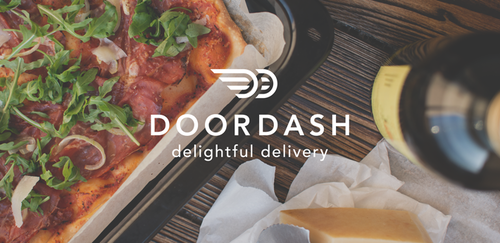
Fourth funding, at two year and five months from founding, two years and two months from launch: In March 2015, DoorDash raises a $40 million Series B led by Kleiner Perkins, with participation from existing investors Sequoia Capital, Khosla Ventures, and Charles River Ventures. Kleiner Perkins' John Doerr joins DoorDash's board. The round values the company at $600 million.
"While today marks another milestone in DoorDash’s story, it feels still like the beginning. Our vision is to build an on-demand marketplace for local merchants that will facilitate commerce in every local economy. After all, it’s not as if local business owners opened their stores because they are passionate about delivery," the company writes.
"We will build the last mile platform to help bring their inventory to the masses. This round of funding will help accelerate our march across the country and invest further in the logistics technology that will scale our platform beyond food."
Platform, at two years and six months from founding, two years and three months from launch: In April 2015, DoorDash launches its app on Android.
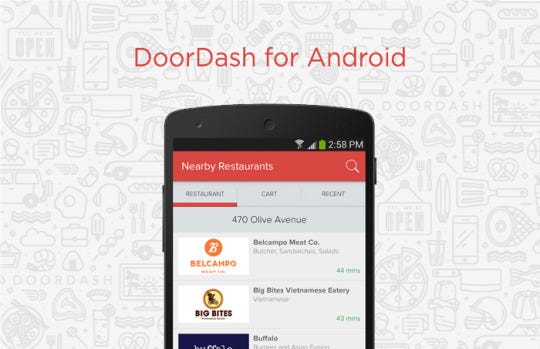
— DoorDash's Fourth Year —
Lawsuit, at three years and one month from founding, two years and 10 months from launch: In November 2015, DoorDash is sued by In-N-Out for trademark infringement and unfair competition. The very next day, DoorDash announces an official partnership with Kentucky Fried Chicken.
"DoorDash has always been about more than delivery. It’s about having convenience at your fingertips, freeing you up to spend your time on what matters most to you. We’ve found a true partner for this vision in KFC, a company built around the idea of getting everyone together around the dinner table with a complete family meal at an affordable price," writes Prahar Shah, Head of Business Development.
The In-N-Out lawsuit is dismissed two months later, but DoorDash agrees to stop delivering from the restaurant's locations.
Geographic expansion, at three years and one month from founding, two years and 10 months from launch: In November 2015, DoorDash expands beyond the United States for the first time, launching operations in Toronto.
Traction, at three years and two months from founding, two years and 11 months from launch: At the end of 2015, DoorDash is in 22 markets, covering more than 250 cities, and it is working with tens of thousands of restaurants.
Fifth funding, at three years and five months from founding, three years and two months from launch: In March 2016, DoorDash raises a $127 million Series C in a round led Sequoia Capital, with participation from existing investors including Kleiner Perkins and Khosla Ventures and new investors Y Combinator Continuity Fund and Wellcome Trust.
Despite reports that the company would be valued at $1 billion, it is ultimately valued at $700 million.
"The fact that in a tough economic market and in a crowded space we were able to raise more than $125 million without resorting to valuation gimmicks and employee-unfriendly terms is a testament to the incredible team, technology and opportunity at DoorDash," writes Xu.
Delivery expansion, at three years and eight months from founding, three years and five months from launch: In June 2016, DoorDash begins offering alcohol delivery in Southern California. The services is launched in conjuction with a partnership with Anheuser-Busch.

— DoorDash's Fifth Year —
Product, at four years and one month from founding, three years and nine months from launch: In November 2016, DoorDash integrates with iMessage to allow for group ordering.

Product, at four years and two months from founding, three years and 10 months from launch: In December 2016, the company launches DoorDash Drive, a fulfillment product that allows businesses to deliver orders that originated outside the DoorDash marketplace.
"From the very start, DoorDash was founded with the goal of being the local logistics layer for every city. To get there, we began by building a consumer-facing marketplace focused on possibly the most complicated item to deliver correctly: food," Abhay Sukumaran, Product Manager, writes.
"Over the past three years we’ve been learning from millions of deliveries, training our data models, and building the technology to get food delivery right. While we continue to double down on restaurant delivery by signing new partners and expanding to new markets, we’ve also been building the tools necessary to support additional types of deliveries through DoorDash and to bring us one step closer toward our ultimate goal of delivering anything from anywhere."
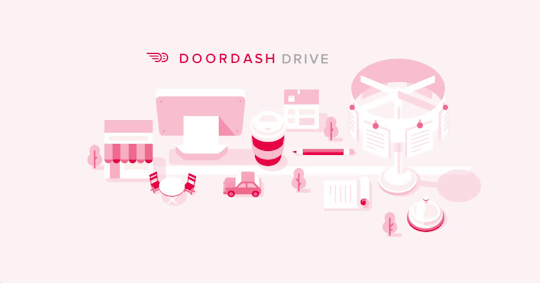
Traction, at four years and two months from founding, three years and 11 months from launch: At the end of 2016, DoorDash is in 28 markets across more than 250 cities.
Product, at four years and three months from founding, four years from launch: In January 2017, DoorDash announces a pilot partnership with Starship Technologies to test integrating delivery robots into DoorDash’s operations. The plan is to use robots to make small, short-distance orders, while using human Dashers to make the bigger deliveries.
"We also plan to explore using robots to bring food from a restaurant to a local hub: with this approach, Dashers would no longer need to park outside a restaurant or wait for the food, but could simply meet a robot at a parking lot to pick up the food and take it directly to the customer. Ultimately, we think we can use robots to improve the Dasher experience and make the deliveries they do even easier and more efficient," the company wrote.
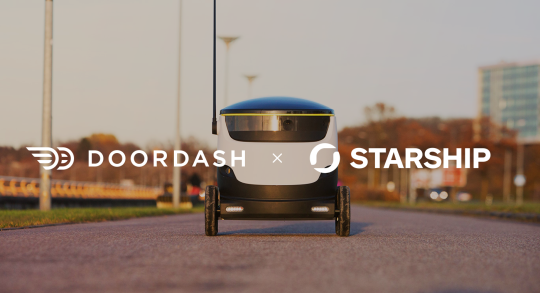
Vehicle types, at four years and six months from founding, four years and three months from launch: In April 2017, DoorDashes partners with zero-emission electric bike company GenZe to offer e-bikes for Dashers in Los Angeles, San Francisco, Vancouver and Washington D.C.

First acquisition, at four years and 10 months from founding, four years and seven months from launch: In September 2017, DoorDash makes its first acquisition, buying Rickshaw, a white-label, same-day local delivery platform and fellow Y Combinator graduate, for an undisclosed amount. The Rickshaw team joined DoorDash, and the company is shut down.
Product, at four years and 10 months from founding, four years and seven months from launch: In September 2017, DoorDash introduces a group ordering feature on its iOS and Android apps, after offering it on the web for two years.
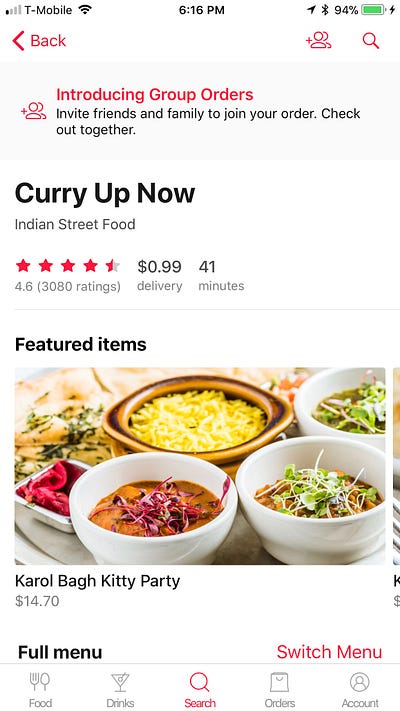
— DoorDash Today —
DoorDash now operates in 56 markets and more than 600 cities across North America.
In March of 2018, the company revealed that it raised $535 million in funding led by SoftBank Group with participation from existing investors Sequoia Capital, GIC and Wellcome Trust. SoftBank’s Jeffrey Housenbold and GIC’s Jeremy Kranz joined the board of directors at DoorDash. With that funding, the company raised a total of $971.8 million and valued it at $1.4 billion. That was followed by another $250 million round in August, which valued it at $4 billion.
BetterHelp and Vator have teamed up for Becoming Us, a virtual group therapy program
Read more...Ginger started by selling health data to providers, before pivoting to becoming a provider itself
Read more...Talkspace was originally called Talktala, and focused on video group therapy sessions
Read more...
Joined Vator on
